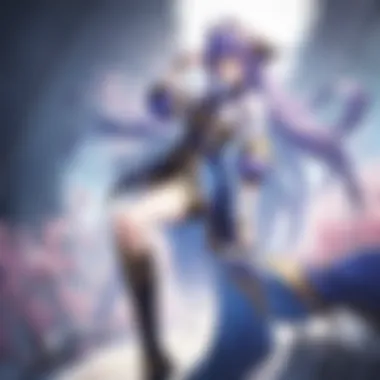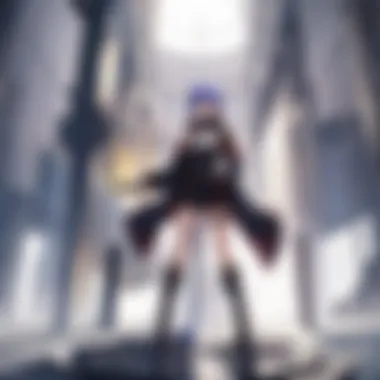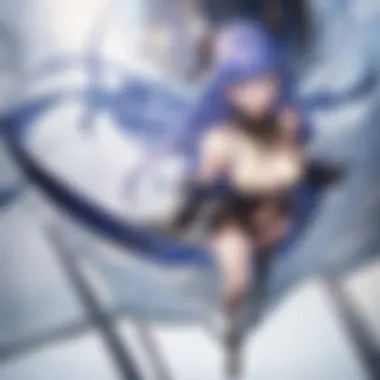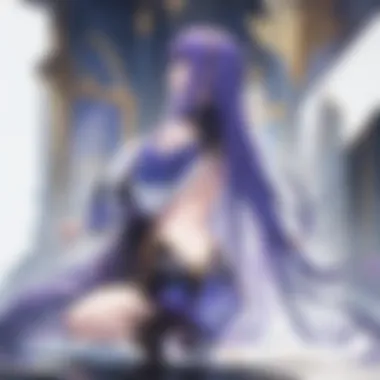Exploring Fate Grand: A Comprehensive Analysis


Intro
The Fate Grand franchise stands as an emblem of modern anime and manga. Its reach extends beyond simple entertainment, drawing in both casual viewers and devoted fans alike. This series, which includes various adaptations and spinoffs, is rooted in the blend of mythology and contemporary storytelling. The interconnected narratives offer layers of complexity that enhance the viewer's experience.
As we journey through this analysis, it is crucial to understand how the franchise evolved. Its origins are steeped in a rich tapestry of literary and historical references, which significantly informs its characters and themes. Through an in-depth examination of the series’ major components, we will uncover the intricacies that have contributed to its profound cultural impact.
Next, we will delve into the core of the franchise with a focus on the featured series, highlighting the elements that define Fate Grand's unique appeal.
Intro to Fate Grand
The Fate Grand franchise stands as a monumental figure in the landscapes of anime and manga. Understanding its significance is essential for grasping the vast narratives and intricate character arcs that unfold within the series. The franchise not only entertains but also raises profound questions about morality, destiny, and what it means to be a hero. Engaging with Fate Grand allows fans to explore these themes while enjoying visually stunning art and compelling storytelling.
The Genesis of the Franchise
The inception of the Fate Grand franchise can be traced back to the visual novel Fate/stay night, released by Type-Moon in 2004. Initially rooted in the realms of interactive storytelling, it introduced audiences to the Holy Grail War, a battle royale where legendary heroes from various histories and mythologies fight to fulfill their masters' desires. Over time, this initial narrative expanded significantly.
Various adaptations, including anime series and film adaptations, have broadened its reach. Each iteration builds upon the first, adding layers to its complex mythos. The franchise is characterized by its unique blend of historical figures, philosophy, and fantasy, presenting a rich tapestry of ideals and conflicts.
It wasn't long before franchise branched into mobile games, most notably Fate/Grand Order, which launched in 2015. This game incorporates turn-based combat mechanics intertwined with collecting characters, effectively merging gameplay with the narrative depth of the existing lore. The popularity it garnered further solidified Fate Grand as a long-lasting entity in the entertainment industry.
Overview of the Series Structure
The structure of the Fate Grand series is multifaceted, encompassing various mediums from visual novels to anime, manga, and games. Each medium offers unique storytelling techniques that contribute to the franchise's overall narrative.
- Anime Adaptations: These adaptations often simplify the complex narrative threads, focusing on key arcs or character relationships. Series such as Fate/Zero and Fate/stay night: Unlimited Blade Works showcase this approach, maintaining engagement with dynamic visuals and poignant dialogue.
- Manga and Light Novels: These formats typically elaborate on characters and plots in ways that are not always explored in animation. For instance, adaptations may delve deeper into character backstories or present alternate outcomes in events that resonate throughout the series.
- Games: The interactive nature of games like Fate/Grand Order allows for exploration and engagement with the characters in a unique way. Players actively partake in the story, interacting with it on a personal level, thereby enhancing their investment in the franchise.
Such a structured yet flexible format allows Fate Grand to appeal to various audiences, each drawn to different aspects of its storytelling. As a result, maintaining interest across generations and demographics becomes a more achievable goal.
Narrative Themes in Fate Grand
In the realm of anime and manga, narrative themes play a vital role in shaping the viewer's experience and understanding of a series. The Fate Grand franchise stands out in this respect by intricately weaving themes of fate, heroism, and moral complexities into its storyline. These elements not only enrich the narrative but also resonate with the audience on a deeper, more philosophical level. This section delves into key themes that run throughout the franchise, presenting important insights into what makes Fate Grand compelling.
The Concept of Fate and Destiny
The theme of fate is central in Fate Grand. The franchise explores how characters grapple with their predetermined paths versus their desires to forge their own destinies. This tension is frequently illustrated through the conflict between Servants and their Masters. Each character's backstory often ties into their understanding of fate, revealing how past decisions continue to influence their present actions. For instance, characters like Shirou Emiya embody attempts to defy fate. The narrative questions whether anyone can truly escape the chains of their destiny or if the struggle against fate is what defines their humanity.
Heroism and Ideals
Another profound theme is that of heroism. Each character in Fate Grand represents different ideals of heroism, shaped by their historical contexts. From noble sacrifices to flawed intentions, the portrayal of heroism prompts viewers to ponder the nature of what it means to be a hero. Characters like Artoria Pendragon reflect the burdens of leadership and the sacrifices made for the greater good. The narratives allow fans to engage with various definitions of heroism, encouraging them to think critically about who they admire and why. These examinations of ideals are not straightforward; instead, they reveal that heroism can often exist alongside significant moral compromises.
Moral Ambiguities
The exploration of moral ambiguities is another essential theme in Fate Grand. Characters often find themselves confronted with daunting choices, revealing the complexity of good and evil. There are no clear distinctions between heroes and villains, as many characters operate within shades of gray. This nuanced storytelling adds layers to the character arcs and maintains an intriguing level of unpredictability. The confrontations and inevitable moral dilemmas faced by characters illuminate the franchise's broader philosophical inquiries. Such themes foster discussions among fans, prompting them to reflect on their own beliefs about right and wrong.
"In Fate Grand, morality is not black-and-white; it is often about the choices that lead us to our ultimate destinies."
Character Analysis in Fate Grand


Character analysis is a vital aspect of the Fate Grand franchise that enriches the narrative landscape. Characters in this universe are not just vessels for storytelling; they embody various philosophical and moral dilemmas. Analyzing these characters allows for a deeper understanding of the themes present in the series. This section delves into the protagonists, antagonists, and supporting characters, revealing the intricate web of relationships and motivations that drive the story forward.
Protagonists: Key Figures
Protagonists in Fate Grand serve as the lens through which the audience experiences the vast complexities of the world. These characters often grapple with their destinies and the burdens of heroism. Key figures, such as Shirou Emiya or Saber, are deeply nuanced, representing diverse ideals and conflicts. Shirou, for instance, embodies the struggle between his ideals and the harsh realities of the world. His journey is not merely about achieving goals but rather understanding what it means to be a hero. This exploration of motivations enrichens the viewer's connection to the character and highlights the overarching themes of choice and sacrifice.
Antagonists: The Complexity of Villainy
The antagonists in Fate Grand are multifaceted, adding depth to the narrative. They are not just obstacles for the protagonists but also characters with their own goals and philosophies. Figures like Gilgamesh or Kirei Kotomine challenge the heroes not only physically but morally and ideologically. These villains often reflect the darker sides of the ideals that the protagonists strive for. For example, Gilgamesh's overwhelming sense of superiority contrasts sharply with Shirou’s more humble nature. This complexity allows viewers to engage with moral ambiguous situations, compelling them to question the very nature of good and evil within the story.
Supporting Characters: The Integral Roles
Supporting characters play an essential role in the Fate Grand universe. They often influence the main characters' development and decision-making. Characters like Rin Tohsaka or Mash Kyrielight provide both guidance and challenges to the protagonists. Their backstories and motivations enrich the narrative, making the bigger picture more engaging. Additionally, they embody various aspects of the themes present in the series, such as loyalty, sacrifice, and personal growth. By analyzing these supporting figures, viewers gain a more rounded view of the story and the various paths that intersect within it.
Characters in Fate Grand are not just plot devices; they are the emotional core of the story that drives the themes of fate, morality, and heroism.
Understanding these character dynamics not only deepens appreciation for the franchise but also enhances discussions about its themes and implications in the realm of anime and gaming.
Artistic Elements of Fate Grand
The artistic elements of Fate Grand play a crucial role in establishing the franchise's distinctive identity. The combination of animation style, character design, and sound design contributes significantly to the overall aesthetic experience. These components do not merely serve decorative purposes; instead, they enhance storytelling, deepen audience engagement, and foster emotional connections with the rich narrative. This section scrutinizes the key artistic components that bring Fate Grand to life, examining their importance and the impact they have on the viewer's experience.
Animation Style and Quality
The animation style in Fate Grand stands out for its meticulous craftsmanship and fluidity. Various adaptations within the franchise showcase different approaches to animation, ranging from traditional hand-drawn techniques to modern digital artistry. Notably, studios such as Ufotable, known for their seamless action sequences and vibrant colors, have set a high standard for quality. The action scenes are choreographed with precision, emphasizing movement and impact, which heightens the tension and excitement.
Additionally, the animation quality varies between different media. For instance, the anime adaptations tend to prioritize lavish visuals that captivate viewers, while video game representations might sacrifice a bit of fluidity for interactive gameplay. Despite these differences, each adaptation retains a unique visual flair, enhancing the viewer's overall immersion into the Fate Grand universe.
Character Design and Visual Themes
Character design is pivotal in establishing the themes and attitudes of Fate Grand. Every character is intricately crafted, highlighting their backgrounds, personalities, and motivations through visual cues. For instance, the protagonist's design typically reflects a combination of strength and vulnerability, inviting viewers to resonate with their journeys. Vibrant colors and distinctive costumes also reinforce individual characteristics, making each figure memorable.
The visual themes across the franchise often mirror its narrative depth. The use of contrasting palettes—vivid hues against darker shades—underscores the moral complexities that characters navigate. Setting designs also reflect cultural and historical influences, enriching the viewer's understanding of the characters' environments. This thoughtful design elevates the storytelling, creating a cohesive aesthetic that parallels emotional and thematic elements.
Sound Design and Music Integration
Sound design in Fate Grand is another essential layer that complements the visual experience. The integration of sound effects enhances the realism of battle scenes, with each clash and impact emphasized to heighten the suspense. The auditory elements are not merely background noise; they actively contribute to the narrative momentum and emotional weight of key moments.
Music plays a significant role as well, with compositions that reflect the franchise's epic scale. From orchestral scores to vocal themes, the soundtrack enhances the emotional landscape of the series. Memorable pieces often accompany pivotal scenes, reinforcing character emotions and audience responses. The careful selection of music creates an immersive atmosphere, prompting viewers to feel deeply invested in the characters' journeys.
"The artistic aspects of Fate Grand are not additional; they are integral to its narrative and emotional core. Each element—animation, design, and sound—works together to create a holistic experience."
As a whole, the artistic elements of Fate Grand exemplify how visual and auditory craftsmanship significantly contributes to storytelling. The meticulous attention to detail and the thoughtful integration of these components enhance the audience's connection to the franchise. Through a combination of striking visuals and immersive sound, Fate Grand continues to have a lasting impact on both anime and gaming communities.
Cultural Context and Impact
The analysis of the Fate Grand franchise cannot overlook its cultural context and impact. This section emphasizes the significance of how this franchise has reshaped perspectives within both anime and gaming environments. The interplay between its themes, characters, and the audience has led to a dynamic cultural exchange, revealing the many layers that contribute to its lasting appeal.


Fate Grand’s Influence on Anime and Gaming
Fate Grand has left an indelible mark on the anime industry and gaming culture. Its unique narrative style and character archetypes have influenced various creators. The ways it incorporates historical figures into diverse storylines provide a framework that numerous shows have since emulated. This franchise also popularized the idea of "gacha" mechanics in mobile gaming, where players summon characters through luck-based systems.
- Innovation in Storytelling
Fate Grand stands out for its complex plots that interweave fate and choice. This depth has inspired new works, prompting writers to explore similar themes in more nuanced ways. - Merchandising and Media Integration
The impact extends into merchandise. Figures, art books, and collaborations with brands reflect the franchise's commercial success.
Global Reception and Popularity
The reception of Fate Grand across the globe demonstrates its broad appeal. From North America to Europe and beyond, fans have embraced its narratives and characters. The franchise has consistently received high ratings from critical sources, indicative of its quality and relevance.
"Fate Grand's cultural significance is not just measured by viewership; it lies in how it continues to engage audiences around the world."
- Mainstream Success
Fate Grand's entry into mainstream media highlighted its universal themes, resonating with diverse audiences. The franchise's ability to convey profound ideas while maintaining accessibility adds to its popularity. - Cultural Adaptation
As the franchise expands, it adapts to various cultural sensitivities without losing its core identity. This adaptability enhances its acceptability and enjoyment across different societies.
Fan Culture and Interactions
The fan community surrounding Fate Grand is robust and passionate. Fans engage through multiple platforms, from fan art on social media to comprehensive discussions in forums.
- Social Media Engagement
Platforms like Reddit and Facebook facilitate discussions, allowing fans to share theories and art. This engagement fosters a sense of belonging and passion among fans. - Contribution to the Franchise
Fans often contribute to the franchise through cosplays, fan fiction, and more. This creative output not only enhances personal connection to the material but also influences the broader cultural narrative of Fate Grand.
Adaptations and Expansions of Fate Grand
The Fate Grand franchise is marked by various adaptations and expansions that have broadened its narrative reach and engaged fans on multiple platforms. This section explores its adaptations into anime, manga, light novels, and video games, revealing how these formats contribute to the richness and longevity of the franchise. Each adaptation serves not only to expand the universe but also to enhance the experience for both new and returning audiences.
Anime Adaptations: A Comparative Overview
Anime adaptations play a crucial role in bringing Fate Grand's complex narratives to life. Several series and films, such as Fate/Zero, Fate/stay night: Unlimited Blade Works, and Fate/Grand Order, differ in style and storytelling methods. For instance, Fate/Zero offers a darker tone, presenting a more mature view of heroism and moral conflict as it delves into the backstories of key characters. On the other hand, Fate/stay night: Unlimited Blade Works emphasizes visual storytelling, showcasing stunning animation that captures intense battles and emotional arcs.
The comparative analysis of these adaptations reveals how different studios, like Ufotable and CloverWorks, interpret the source material. Their distinct artistic choices shape fans’ understanding of the overarching themes and character dynamics. The transition from visual novel to anime highlights the challenge of condensing detailed narratives into digestible episodes. This adaptation process underscores the significance of fidelity to the original work while allowing creative freedom to explore new narrative pathways.
Manga and Light Novels: Expanding the Universe
Manga and light novels serve to enrich the Fate Grand universe by exploring narratives not fully captured in anime. Works such as Fate/Grand Order: Epic of Remnant introduce side stories and characters that enhance the overall narrative complexity. These adaptations often provide deeper insight into characters’ motivations and backgrounds that the main adaptations might overlook.
Light novels, like Fate/Apocrypha, present alternative timelines and reimagined versions of familiar characters. This expansion allows fans to engage with the universe in varied ways, inviting them to explore new interpretations of established lore. The written format offers a unique opportunity for detailed exposition and internal character dialogues, creating a richer emotional landscape.
Through manga and light novels, the franchise cultivates a space for creativity, enabling fans and creators to push the boundaries of the original concept. The interplay between these mediums fosters a more immersive experience for the audience, bridging gaps between various adaptations and enhancing comprehension of intricate plotlines.
Video Game Spin-offs: Engaging Gameplay Experiences
Video game spin-offs like Fate/Grand Order have opened avenues for interactive storytelling within the franchise. This mobile game not only allows players to engage with popular characters but also immerses them in the rich lore of the Fate universe. The gameplay combines turn-based combat with deep narrative choices, adding layers of strategy and personalization.
Each event within the game often corresponds with specific story arcs found in the anime or light novels, creating a cohesive experience across multiple platforms. The success of Fate/Grand Order indicates that interactive experiences can attract a broader audience beyond traditional anime viewers. This adaptability emphasizes the versatility of the Fate Grand franchise, demonstrating its ability to resonate with diverse demographics.
With each adaptation and expansion, Fate Grand asserts its position as a multifaceted franchise, inviting fans from various backgrounds to partake in its narratives. By exploring different mediums, it continually evolves, ensuring its relevance and appeal in the ever-changing landscape of anime and gaming.
Thematic Evolution Across Fate Grand


The Fate Grand franchise has not remained stagnant; rather, it has evolved significantly over the years. This evolution reflects broader changes in societal norms and audience expectations. Understanding this thematic evolution is crucial for grasping the series' enduring relevancy and depth. The adaptation of themes allows the franchise to explore various aspects of human nature, morality, and relationships.
Shifts in Narrative Focus
Over the years, the narrative focus within Fate Grand has shifted in response to both character arcs and the larger thematic ambitions of the franchise. Initially, stories were heavily centered on the mechanics of the Holy Grail War and the combat between Servants. However, as the franchise expanded, there was a noticeable transition toward character-driven plots. These stories began to delve deeper into the motivations and psychological complexities of not just the heroes but also the villains.
The expansion into different adaptations has also encouraged this shift in focus. For instance, the anime adaptation of Fate/Zero takes a more gritty and philosophical approach compared to its predecessors. This series analyzed themes of sacrifice and the philosophical weight of the characters' decisions, setting a precedent for future installments.
Character Development Trajectories
Character development trajectories in Fate Grand are crucial for its thematic evolution. Key figures often undergo transformative journeys. Their growth challenges their ideals and compels them to confront their pasts. Each character's development is reflective of broader themes such as redemption, heroism, and the conflict between personal and greater good.
For example, Shirou Emiya from Fate/stay night can be seen grappling with the burden of ideals versus reality. As the story unfolds, Shirou's journey becomes a representation of the internal struggle faced by many characters in the franchise.
"In the end, the ideals we chase become reflections of the choices we make."
The complexity of these character trajectories enhances the narrative depth and keeps audiences engaged. The blending of individual growth with overarching narratives provides a rich tapestry that continues to evolve. Therefore, the exploration of these themes allows for a meaningful engagement with the franchise that resonates with both new viewers and long-time fans.
Future Prospects of the Fate Grand Franchise
The future of the Fate Grand franchise is a topic of significant interest among fans and stakeholders alike. It is important to understand the potential directions the series could take. This examination can provide insights into how new projects might align with existing themes and character arcs, as well as the overall impact on the community. Recognizing the possible trajectories can highlight the sustained relevance of this franchise in a competitive landscape.
Upcoming Projects and Developments
As of now, multiple projects are anticipated within the Fate Grand franchise. These developments indicate a commitment to expanding this universe.
- New Anime Adaptations: There are rumors about upcoming anime series that could delve deeper into lesser-explored story arcs. The adaptations can attract both existing fans and new viewers.
- Mobile Game Updates: The mobile game, Fate/Grand Order, regularly introduces new content. Future updates may include collaborations with different properties, expansions into new narratives, and additional character releases.
- Spin-off Titles: The franchise's success may lead to more spin-off titles in various formats such as manga or light novels, which are aimed to cater to niche audiences.
These upcoming projects signify the ongoing evolution of the franchise. The anticipation for new content can generate excitement and discussion in the community.
Sustainability of the Franchise's Appeal
The longevity of the Fate Grand franchise relies on its ability to evolve while remaining true to its roots. Sustainability can be approached from several angles.
- Innovative Storytelling: Maintaining fresh and engaging narratives will be vital. The success of story-based media often lies in its ability to surprise its audience while keeping core themes intact.
- Engagement with Fanbase: Active communication and engagement with the community can create a stronger sense of belonging. Hosting events or utilizing platforms like Reddit and Facebook to gather feedback can further enhance this connection.
- Cultural Relevance: Adapting themes that resonate with contemporary issues while remaining faithful to the essence of the franchise can help in sustaining interest.
"The continued success of the Fate Grand franchise depends on its balance between innovation and tradition."
Culmination: The Enduring Legacy of Fate Grand
The Fate Grand franchise stands as a significant cultural artifact within the anime and manga landscape. Its lasting appeal can be attributed to various factors that resonate deeply with its audience. First, the franchise's unique narrative structure offers viewers a complex interplay of fate, heroism, and moral dilemmas. These themes engage audiences on an emotional level, allowing them to connect with characters on multiple fronts.
Additionally, the creativity behind character design and visual presentation elevates the narrative further. A vast array of characters, each with distinctive backgrounds and motivations, adds layers to the storyline, encouraging fans to explore deeper meanings behind their actions.
The integration of various media formats—from anime adaptations to video games—has also played a key role in maintaining and expanding the franchise's reach. This multifaceted approach keeps the content fresh and accessible to both seasoned fans and newcomers. Furthermore, the sense of community fostered among fans has helped cement its status in popular culture. This interaction can be observed on platforms like Reddit and Facebook, where discussions about the franchise continue to thrive.
Overall, the enduring legacy of Fate Grand is a result of its innovative storytelling, rich character development, and community engagement. It serves as an example of how a franchise can evolve and adapt over time, retaining relevance in an ever-changing cultural environment.
Final Reflections on Its Impact
Fate Grand's impact extends beyond mere entertainment. It has shaped discussions about narrative forms within anime and set benchmarks for character complexity in storytelling. The way it handles themes of destiny and morality prompts viewers to reflect on their own beliefs and choices.
Moreover, its contribution to the overall landscape of anime and gaming cannot be understated. Other media often look to Fate Grand’s innovations, influencing how future projects approach character depth and narrative intricacies. The ongoing popularity ensures that debates about characters and themes remain vibrant, sustaining interest long after the initial engagement with the franchise.



